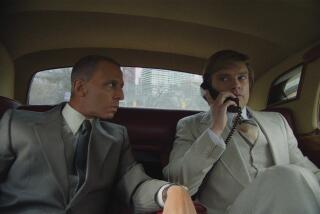In-your-face journalism
- Share via
LAST SUNDAY, doctors in France performed a history-making partial face transplant on a 38-year-old woman who’d lost her mouth, chin and nose after a dog attack. By Wednesday morning, the American news media was all over the story, and by that evening, broadcasters were challenging each other to see how quickly they could segue from serious medical coverage to the more revenue-producing stuff of cosmetic surgery and celebrities.
On CNN’s “The Situation Room,” Wolf Blitzer joined “The Cafferty File’s” Jack Cafferty in an odd little soft-shoe routine about what would happen if face transplants became the hottest new thing in elective cosmetic surgery. “An extreme makeover indeed!” Blitzer intoned. Cafferty, leading with a disclaimer about having “a little fun with a serious story,” extrapolated even further, reading viewer responses to a survey about what celebrity faces they’d covet if transplants became as commonplace as lifts.
In true American fashion, most preferred a composite -- a greatest hits medley of ideal celebrity features that, wouldn’t you know it, ranged from “Anderson Cooper’s face for job interviews” to “Wolf Blitzer’s face [so] I could fly to Washington and pick up groupies in the bars there by telling them I am the Wolfman.”
Funny stuff. Someone should put these guys on morning drive talk radio.
But CNN was hardly the only news outlet that managed to turn a gruesome medical report (a European one, no less) into a sci-fi human interest feature. Just about everyone ran clips from the 1997 movie “Face/Off” -- in which hero John Travolta and villainous Nicholas Cage exchanged faces and identities through futuristic plastic surgery -- and several broadcasters felt compelled to wrap up the story by noting that doctors were, alas, not considering the possibility of elective face transplants in the future (the implication being, “But we sure are!”).
Sure, there continue to be a few ethical issues around the edges of this story. Some experts criticized the French doctors for not first attempting more traditional reconstructive surgery. It was also pointed out that the patient was not necessarily going to die without the surgery. This was, according to doctors, a quality-of-life issue rather than a life-or-death matter. There is a very real short-term possibility of organ rejection, as well as a long-term chance that the patient will develop cancer due to some of the anti-rejection drugs.
But these issues by themselves just aren’t sexy enough for TV. Because today’s news is all about relating to the audience, about delivering news that touches people right in their living rooms, it’s only natural they’d give us the story we really want. It’s not a medical story, and it’s certainly not a story happening in France. It’s the story about what it means to be freedom-loving people (you know, the ones whose way of life the insurgents hate). It’s the story about how, in a great democracy, we can say what we wish, worship any God we choose and have any damn face we want, even if it bears no relationship to our DNA.
Apparently, free people are all supposed to look alike. Over the last decade or so, a giant eraser seems to have rubbed against our collective concept of the human face, rendering it at once “more perfect” and increasingly forgettable. Even in places outside of Los Angeles, where in some communities cubist faces rule the day, it seems more and more difficult to tell people apart from one another.
A sort of McMansion effect is beginning to settle across our facial plains. Like old houses that are bulldozed to make room for enormous prefabs, we’re tossing out our own histories in favor of noses or cheekbones that may, perversely, reflect the values of our current society but have nothing to do with our heritage, our families or even sometimes our ethnicity. It’s yet another triumph of the present over the past. Why look like Aunt Hilda when we can look like Paris Hilton?
IT WAS, OBVIOUSLY, not always thus. One need only look at films that predate, say, 1985, and it’s almost astonishing how much our definition of beauty has narrowed since plastic surgery became so easily accessible. We do not see many movie stars these days whose glamour takes the less conventional form of a Bette Davis or a Humphrey Bogart or a Meryl Streep.
Is it any wonder that teenagers and 20-somethings these days are enamored of a look (blond, tan and proudly augmented) that, as recently as the early 1980s, would have been dismissed as cheesy and artificial? In this age of teenager as tastemaker and surgeon as god, carving out an identity is less about developing a personality than carving yourself into the form of someone from “The O.C.”
That makes the notion of being attacked by a dog and losing your face unspeakably terrifying, so much so that broadcasters (some of whom are perhaps a bit too familiar with facial surgery) preferred to change the subject entirely.
It’s an entertaining parlor game, this question of whose lips would you choose and which face of a dead celebrity might take the highest sum at auction.
But the whole question is less a news story than it is proof of the way we’ve begun to rewire our relationship to our own histories. It’s revisionist history to be sure, and the scalpel is leading the way.
More to Read
The biggest entertainment stories
Get our big stories about Hollywood, film, television, music, arts, culture and more right in your inbox as soon as they publish.
You may occasionally receive promotional content from the Los Angeles Times.











